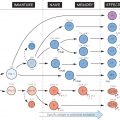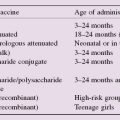The first strong evidence for distinct lymphocyte populations was the complementary effects in birds of early removal of the thymus (which mainly affects cell-mediated immunity) and the bursa of Fabricius (which affects antibody responses). A continuing puzzle has been the identification of what represents the bursa in mammals; despite a phase when ‘gut-associated lymphoid tissue’ was a popular candidate, current opinion considers there to be no true analogue, the liver taking over the function of B-cell maturation in the fetus, the bone marrow in the adult.
The production of both B and T lymphocytes is a highly random and, at first glance, wasteful process, quite unlike any other form of haemopoiesis. It involves the rearrangement of genes to give each cell a unique receptor molecule (for details see Figs 12 and 13) and the elimination of all those cells that fail to achieve this, plus those that carry receptors that would recognize ‘self’ molecules and thus be potentially self-destructive (see Fig. 38). As recognition by T cells is more complex, involving the MHC as well as foreign antigen (see Figs 11, 12 and 18), production of T cells is a correspondingly more elaborate process, requiring two separate selection steps, one for self-MHC and one against self-antigens.
Both B- and T-cell development involves rapid and extensive cell proliferation. Cytokines (especially IL-2 and IL-7) have a key role in driving this cell expansion, and genetic defects in their receptors (e.g. common γ-chain deficiency) results in profound immunodeficiency (see Fig. 33). The repair of these genetic defects has been one of the first successful applications of the novel field of gene therapy to medicine.
Yolk Sac
The source of the earliest haemopoietic tissue, including the lymphocyte precursors.
Bursa
In birds, B lymphocytes differentiate in the bursa of Fabricius, a cloacal outgrowth with many crypts and follicles, which reaches its maximum size a few weeks after birth and thereafter atrophies. Despite claims for the appendix, tonsil, etc., there is probably no mammalian analogue.
M
Medulla; the region where the first stem cells colonize the bursal follicles.
C
Cortex; the site of proliferation of the B lymphocytes.
Liver
During fetal life in mammals, the major haemopoietic and lymphopoietic organ.
Bone Marrow
Stay updated, free articles. Join our Telegram channel

Full access? Get Clinical Tree





